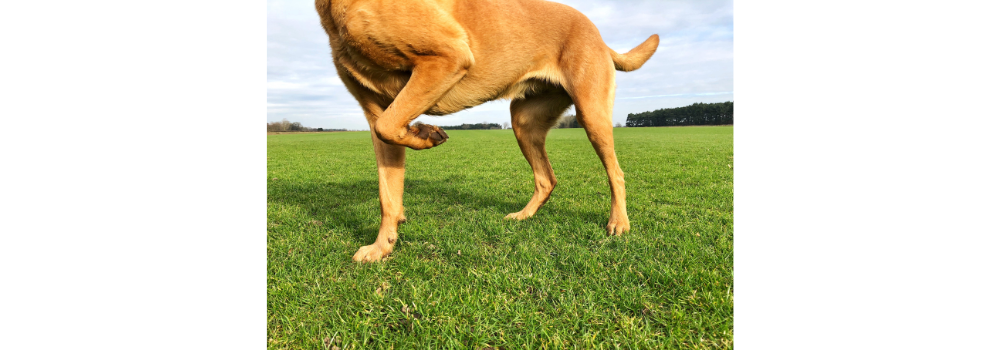
September is National Pain Awareness Month. As pet lovers, we want to know when our pets experience discomfort or distress.
Dogs, and especially cats, have evolved to mask their pain. Exhibiting signs of pain is a sure way to become the target of a predator. So, even though a lot of time has passed, these tendencies to mask pain have not. It's up to us to be keen observers as advocates for our pets.
Understanding the signs of pain in both dogs and cats is essential to ensure their well-being and provide them with the care they deserve. In this blog post, we'll delve into the world of canine and feline pain, exploring how signs may differ between these two species and how to recognize when your pet could be hurting.

Are we underestimating the number of dogs and cats experiencing pain?
When it comes to arthritis, we know from research that about 40% of all dogs and about 40% of all cats have some degree of osteoarthritis. Unfortunately, way less than 40% (and I believe this number is underestimated greatly for pets over 6 years of age) present to a veterinary clinic for pain (1). By age 12 90% of cats have radiographic signs of arthritis. So what are we missing?
Should we focus on X-rays or Symptoms?
When it comes to pain, the most important thing to note is a change in habits. A pet with obvious arthritis on X-rays may not be having pain. I remember one surgeon saying in a lecture I attended that "dogs don't walk on their X-rays". Instead, we must consider that the most important point to consider for pain in dogs and cats in pain is that they will often have a change in habits. They usually sleep upstairs with you, but now they stay downstairs. They usually get up before you, and now they are not getting up to run to the door when you first get out of bed. These changes may occur gradually, so we may not recognize them.
Understanding Pain in Dogs:
Dogs, like humans, exhibit changes when they are in pain. However, being masters at hiding discomfort, they may not show overt signs until the pain becomes severe. Since physical signs of pain occur gradually, we may not recognize it.
Think of the Labrador that gets up stiffly and limps some getting started, but the leash comes out, and they suddenly switch gears, and the tail goes, and the game is on. Unfortunately, they may be in chronic pain even though they are wagging their tail vigorously.
We need to do what we can to be their advocate, as they are likely to overdo it and be in more acute pain afterward.

Signs of pain in dogs
There are obvious signs of pain in dogs, such as limping, but more often, there are subtle signs.
Behavioral Signs:
Look out for decreased appetite, increased irritability or aggression, restlessness, avoidance of certain movements, or excessive licking of a specific body part. Dogs that have allergies will lick their feet which can sometimes be confused with pain.
Dogs with ear or dental pain may not want their head petted.
Altered Posture and Movement and Mobility Issues:
The most obvious and common signs of pain include changes in ambulation. Pay attention to reluctance to climb stairs, hesitation or difficulty jumping into the car, difficulty in standing up or lying down, hunched back, stiffness, or lameness.
Dogs with hip or low back pain may adopt a "bunny hopping" gait to avoid hip and back extension. They may walk with a sashay in their rear as they compensate for their hip pain.
Dogs with knee arthritis may sway their back more to one side as they use their back to compensate for the lack of range of motion in the knee.
There may be difficulty getting into a comfortable position as they lay down, and you may see twitching muscles shaking or trembling.

Vocalizations and Expressions:
There may be subtle signs like panting when it's cool out, ears back, a tucked tail, or slight grimace to the face. More obvious signs of pain in dogs include whining, whimpering, groaning, and in acute pain the pupils may be dilated.
Changes in Appetite and Bathroom Habits:
Monitor any changes in eating or elimination patterns, as they can reveal hidden discomfort. It may become difficult to posture and have a bowel movement for a dog with back pain.
Systemic signs of pain in dogs and cats:
Increased heart rate is common when a dog is in pain. The stress of chronic pain leads to immune suppression and, left untreated, can become very hard to treat as the nervous system "memorizes" it if pain management is not instituted.
Pets that have pain may be more reluctant to go outside as much. Because they are more likely to retain urine longer, they are prone to urinary tract infections.

Recognizing Pain in Cats:
Cats are particularly adept at masking their pain, making it challenging for even the most attentive cat parents to spot the signs. While some signs of pain in cats overlap with those in dogs, others are unique to our feline friends:
Behavioral Changes:
Cats may become more withdrawn. They may have clumped hair on their back as they have stopped grooming themselves or started over-grooming a specific area. They may also display changes in their interactions with humans and other pets.
Cats with dental or ear pain, or pain anywhere for that matter, may not enjoy being petted.

Altered Posture and Movement:
Remember that cats are more likely to have difficulty moving vertically rather than horizontally. You might be inclined to think that they have finally learned to stay off the counters when in reality, they can't get up there anymore. They may try and miss, and you might see scratches on surfaces where they are using their nails to try and get onto a surface they can no longer navigate lithely.
Cats do not usually injure one leg, such as a ruptured cruciate ligament in a dog. Instead, they will have bilateral arthritis, usually as a manifestation of chronic pain. So, we may not observe an obvious lameness as it would occur symmetrically in both legs and not one, which would create a more obvious limp.
In addition to reluctance to jump onto surfaces, they may exhibit stiffness or trouble moving or adopt an unusual posture, such as sitting stiffly, with their legs collected under them and their back hunched.
Vocalizations and Expressions:
Some cats might become more vocal, while others may become silent. Look out for signs like dilated pupils, flattened ears, or a tucked tail.

Changes in Appetite and Bathroom Habits:
The most common thing I see is eliminating outside the box. It may help to use a under the bed garment box with the front cut out so they can just walk in, and obviously you can get one that gives them more space. This may help for some. Other cats are actually using the box to rest their hind end and defecate or urinate over the edge.
Cats may also show decreased appetite, and changes in drinking habits.
Physical signs of pain in dogs and cats

A visit to a veterinary clinic is warranted when you feel heat or swelling in any joint. It may also be helpful to take a video of your dog walking or running. It's also helpful to see a video of your dog or cat climbing the stairs. They may have an altered gain, like stepping and hopping or stopping along the way.
Recognizing the signs of pain in our pets is the first step toward ensuring their comfort and well-being. By observing our dogs' and cats' behavior, habits, posture, appetite, bathroom habits, and physical condition, we can play an active role in identifying and addressing their discomfort. It's critical we are observant as chronic pain often goes unrecognizable.
Steps to reduce pain and prevent it
The sooner we recognize pain we can institute preventatives such as joint supplements, physical therapy, and other preventive treatments. Treatment options will be a focus of our blog posts this month, so stay tuned.
Studies have shown that a dog's weight can have a significant impact on the severity of arthritis. Overweight or obese dogs are more likely to suffer from arthritis, and experience worsened symptoms compared to their lean counterparts.
The Most Common Medical condition that Increase Pain

According to research, obesity is a common risk factor for arthritis in dogs, particularly in large-breed dogs. The excess weight places additional stress on the joints, leading to increased wear and tear, inflammation, and pain. One study found that overweight dogs have a shorter lifespan and an increased susceptibility to diseases such as hip dysplasia and arthritis compared to lean dogs.
In a study examining the effects of weight loss on dogs with cranial cruciate ligament rupture, it was observed that overweight dogs had poorer short-term and long-term outcomes, regardless of whether they were treated surgically or non-surgically. This suggests that weight loss plays a crucial role in managing arthritis and improving overall joint health.
Furthermore, another study highlighted the therapeutic efficacy and safety of undenatured type II collagen, along with glucosamine and chondroitin, in arthritic dogs. It emphasized that arthritis commonly affects large-breed dogs due to overweight/obesity, further underlining the correlation between weight and joint health (2).

The impact of weight on arthritis in dogs and cats extends beyond physical discomfort. Overweight pets face a higher risk of developing other health issues, such as diabetes. These conditions can further exacerbate the discomfort associated with arthritis, making weight management a crucial aspect of overall wellness.
The statistics and studies cited above provide valuable insights into the relationship between a dog's weight and arthritis. It is essential for pet owners to be aware of the potential consequences of obesity on their furry friends' joint health. By maintaining a healthy weight through proper nutrition and regular exercise, pet owners can help reduce the risk and severity of arthritis in their dogs, ultimately improving their quality of life.
At Holistic Vet Blend, we understand the importance of your pet's health and happiness. Our nutrient premixes allow you to make a nutrient, antioxidant rich diet with whole foods. Our Omega-3 fish oil is a great addition to immune system support and ensures a healthy Omega-3 to Omega-6 ratio, which promotes the overall health of the entire body, including the joints.
Increasing the amount of fish oil beyond that in your pet's regular has shown modest improvements in the clinical signs of overweight arthritic dogs (3).
Together, let's commit to understanding and alleviating our pets' pain during Pain Awareness Month and beyond. We will focus on pain management this month, so stay tuned for more things that you can do to give your pets their best life!
Sources:
- Roudebush, P., Schoenherr, W. D., & Delaney, S. J. (2023). An evidence-based review of the use of nutraceuticals and dietary supplementation for the management of obese and overweight pets. The Veterinary Record, 192(4).
- Roudebush, W., Schoenherr, W. D., & Delaney, S. J. (2008). An evidence-based review of the use of nutraceuticals and dietary supplementation for the management of obese and overweight pets. Journal of the American Veterinary Medical Association, 232(11), 1646-1655.
- Fritsch, D., Allen, T. A., Dodd, C. E., Jewell, D. E., Sixby, K. A., Leventhal, P. S., & Hahn, K. A. (2010). Dose-titration effects of fish oil in osteoarthritic dogs. Journal of Veterinary Internal Medicine, 24(5), 1020-1026.










